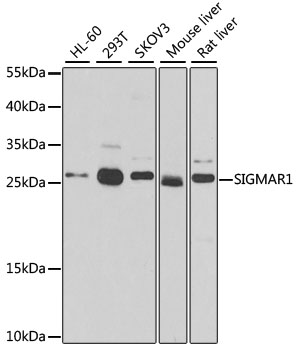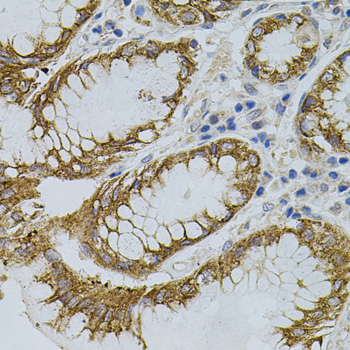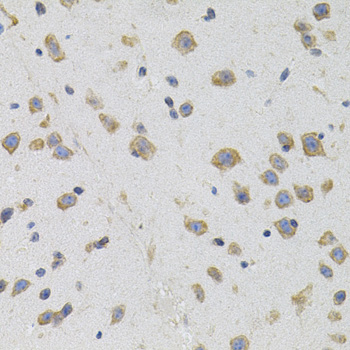Anti-SIGMAR1 Antibody (CAB5479)
- SKU:
- CAB5479
- Product type:
- Antibody
- Reactivity:
- Human
- Mouse
- Rat
- Host Species:
- Rabbit
- Isotype:
- IgG
- Antibody Type:
- Polyclonal Antibody
- Research Area:
- Cell Biology
Frequently bought together:
Description
| Antibody Name: | Anti-SIGMAR1 Antibody |
| Antibody SKU: | CAB5479 |
| Antibody Size: | 20uL, 50uL, 100uL |
| Application: | WB IHC |
| Reactivity: | Human, Mouse, Rat |
| Host Species: | Rabbit |
| Immunogen: | Recombinant protein of human SIGMAR1 |
| Application: | WB IHC |
| Recommended Dilution: | WB 1:500 - 1:2000 IHC 1:100 - 1:200 |
| Reactivity: | Human, Mouse, Rat |
| Positive Samples: | HL-60, 293T, SKOV3, Mouse liver, Rat liver |
| Immunogen: | Recombinant protein of human SIGMAR1 |
| Purification Method: | Affinity purification |
| Storage Buffer: | Store at -20°C. Avoid freeze / thaw cycles. Buffer: PBS with 0.02% sodium azide, 50% glycerol, pH7.3. |
| Isotype: | IgG |
| Sequence: | Email for sequence |
| Gene ID: | 10280 |
| Uniprot: | Q99720 |
| Cellular Location: | Cell junction, Cell membrane, Cell projection, Endoplasmic reticulum membrane, Lipid droplet, Nucleus inner membrane, Nucleus outer membrane, growth cone |
| Calculated MW: | 11kDa/21kDa/22kDa/25kDa |
| Observed MW: | 25kDa |
| Synonyms: | SIGMAR1, ALS16, DSMA2, OPRS1, SIG-1R, SR-BP, SR-BP1, SRBP, hSigmaR1, sigma1R |
| Background: | This gene encodes a receptor protein that interacts with a variety of psychotomimetic drugs, including cocaine and amphetamines. The receptor is believed to play an important role in the cellular functions of various tissues associated with the endocrine, immune, and nervous systems. As indicated by its previous name, opioid receptor sigma 1 (OPRS1), the product of this gene was erroneously thought to function as an opioid receptor; it is now thought to be a non-opioid receptor. Mutations in this gene has been associated with juvenile amyotrophic lateral sclerosis 16. Alternative splicing of this gene results in transcript variants encoding distinct isoforms. |
| UniProt Protein Function: | SIGMAR1: Functions in lipid transport from the endoplasmic reticulum and is involved in a wide array of cellular functions probably through regulation of the biogenesis of lipid microdomains at the plasma membrane. Involved in the regulation of different receptors it plays a role in BDNF signaling and EGF signaling. Also regulates ion channels like the potassium channel and could modulate neurotransmitter release. Plays a role in calcium signaling through modulation together with ANK2 of the ITP3R-dependent calcium efflux at the endoplasmic reticulum. Plays a role in several other cell functions including proliferation, survival and death. Originally identified for its ability to bind various psychoactive drugs it is involved in learning processes, memory and mood alteration. Defects in SIGMAR1 are the cause of amyotrophic lateral sclerosis type 16, juvenile (ALS16). ALS16 is a neurodegenerative disorder affecting upper motor neurons in the brain and lower motor neurons in the brain stem and spinal cord, resulting in fatal paralysis. Sensory abnormalities are absent. The pathologic hallmarks of the disease include pallor of the corticospinal tract due to loss of motor neurons, presence of ubiquitin-positive inclusions within surviving motor neurons, and deposition of pathologic aggregates. The etiology of amyotrophic lateral sclerosis is likely to be multifactorial, involving both genetic and environmental factors. The disease is inherited in 5- 10% of the cases. Belongs to the ERG2 family. 5 isoforms of the human protein are produced by alternative splicing. |
| UniProt Protein Details: | Protein type:Receptor, misc.; Nuclear envelope; Membrane protein, integral Chromosomal Location of Human Ortholog: 9p13.3 Cellular Component: integral to membrane; integral to plasma membrane; nuclear envelope Molecular Function:drug binding Biological Process: regulation of neuron apoptosis Disease: Amyotrophic Lateral Sclerosis 16, Juvenile; Spinal Muscular Atrophy, Distal, Autosomal Recessive, 2 |
| NCBI Summary: | This gene encodes a receptor protein that interacts with a variety of psychotomimetic drugs, including cocaine and amphetamines. The receptor is believed to play an important role in the cellular functions of various tissues associated with the endocrine, immune, and nervous systems. As indicated by its previous name, opioid receptor sigma 1 (OPRS1), the product of this gene was erroneously thought to function as an opioid receptor; it is now thought to be a non-opioid receptor. Mutations in this gene has been associated with juvenile amyotrophic lateral sclerosis 16. Alternative splicing of this gene results in transcript variants encoding distinct isoforms. [provided by RefSeq, Aug 2013] |
| UniProt Code: | Q99720 |
| NCBI GenInfo Identifier: | 74752153 |
| NCBI Gene ID: | 10280 |
| NCBI Accession: | Q99720.1 |
| UniProt Secondary Accession: | Q99720,O00673, O00725, Q0Z9W6, Q153Z1, Q2TSD1, Q53GN2 Q7Z653, Q8N7H3, Q9NYX0, D3DRM7, |
| UniProt Related Accession: | Q99720 |
| Molecular Weight: | 21,013 Da |
| NCBI Full Name: | Sigma non-opioid intracellular receptor 1 |
| NCBI Synonym Full Names: | sigma non-opioid intracellular receptor 1 |
| NCBI Official Symbol: | SIGMAR1 |
| NCBI Official Synonym Symbols: | SRBP; ALS16; DSMA2; OPRS1; SR-BP; SIG-1R; SR-BP1; sigma1R; hSigmaR1 |
| NCBI Protein Information: | sigma non-opioid intracellular receptor 1 |
| UniProt Protein Name: | Sigma non-opioid intracellular receptor 1 |
| UniProt Synonym Protein Names: | Aging-associated gene 8 protein; SR31747-binding protein; SR-BP; Sigma 1-type opioid receptor; SIG-1R; Sigma1-receptor; Sigma1R; hSigmaR1 |
| Protein Family: | Sigma non-opioid intracellular receptor |
| UniProt Gene Name: | SIGMAR1 |
| UniProt Entry Name: | SGMR1_HUMAN |









